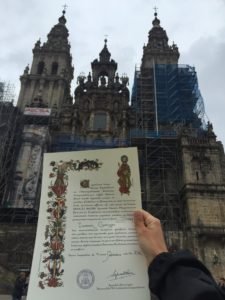Must-know Terms and Symbols on the Camino de Santiago
The Camino is steeped in centuries of history, and along with this age-old history, you’ll find many distinct symbols along the Camino de Santiago. As one prepares to walk the Camino, it’s helpful to know what these symbols mean and interesting to learn the backgrounds and legends behind these symbols.
Terms to know when walking the Camino de Santiago
Pilgrim
First and foremost, we’ve got the term ‘pilgrim’. A pilgrim is a term to describe anyone who is walking a pilgrimage. Even if you may not identify with being a pilgrim at first, especially if you’re walking the Camino as a hike or to get be in nature, it’s important to know this phrase as you may be referred to as a pilgrim by locals or people you meet along the way. In Spanish, the word for pilgrim is peregrino. If you identify as a female, it’s peregrina with an -a.
Camino symbols and terms
Credential
Next, you’ll hear the term ‘credential’ (credencial in Spanish) otherwise known as the Pilgrim’s Passport. These two terms can be used interchangeably. Credentials were used beginning in Medieval times as a safeguard to ensure that the pilgrim did in fact walk the entire route of the Camino. Because many of the accommodations along the way are also only meant for pilgrims, it’s a way to prove that you’re a Camino pilgrim. Along the way, you’ll stamp your passport or the accommodations will stamp it for you.
Your pilgrim’s credential can usually be provided at the first hostel or at tourist offices located at key points on the Route like starting points or bigger towns. You can also order it online before you leave for your trip - Go to AmericanPilgrims.org to order your credential! The price of the Camino de Santiago Passport ranges between 50¢ and €2.
Compostela
“Compostela” is the official document that certifies a pilgrim has completed the Camino de Santiago. The Pilgrim’s Office in Santiago will check your Credential to make sure you walked at least 100 km or biked at least 200 km.
Free Camino de Santiago Guide
Buen Camino
Finally, you’ll constantly hear the term ‘buen Camino’ when walking the Camino. It’s a greeting that basically means, have a good Camino or good walk. In Portuguese it’s bom caminho and in French, it’s bon chemin.
Symbols along the Camino de Santiago
Yellow arrows
You’ll see yellow arrows on the Camino as a sign that you’re on the path. When you see these yellow arrows, you know you’re not lost! Elías Valiña, a pastor from O Cebriero along the Camino Frances, began to paint the path with this symbol. This Camino symbol spread all along the way, and now you’ll see it throughout the trail.
Camino symbols and phrases
Scallop shell
Back in the day, the accreditation for completing the pilgrimage was a badge in the form of a scallop shell. This is likely to be because the scallop shell is native to Galicia.
By the 13th century, vendors and shops in Santiago de Compostela began selling scallop shells in Santiago itself.Nowadays, if you see someone wearing a shell on their bag, it’s a symbol that they’re a pilgrim. Plus, you’ll see the scallop shell along the Camino, which shows you’re on the right path similar to the yellow arrow.
You’ll receive a scallop shell when you go to the Pilgrim’s Office the day before you start walking your Camino.
Concluding Thoughts
Keep in mind these terms and symbols while walking the Camino de Santiago, and enjoy every step of the way! Follow us on Instagram for Camino news and photos.



